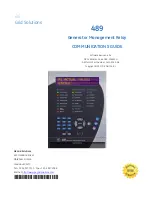
LGMRU4X4.v2 Masthead Relay Unit Installation Handbook.
Page 8
PROGRAMMING:
The new version LGMRU4x4v2 now has an LED display and push buttons to set
the mode of operation.
This makes changing settings much easier and facilitates more options and
features.
Button functions.
SELECT
UP
M
MEMORISE
DOWN
Power On,
When the power is turned on, the display shows
momentarily.
How to set standard functions.
Step 1.
Enter the settings mode. Press
M
until the display shows
Step 2.
Scroll through the mode options with this button
EG:
When the desired mode is reached, wait a moment and then the
dis-
play will flash the setting.
EG: = site code 1.
To change a setting, se-
lect the mode and wait for the setting to flash.
Scroll up or down to the desired number.
Step 3.
Press and hold the
M
button to store the new number.
The display shows
followed by
Now let go of the
button and
the new setting is now stored.
EXAMPLE:
M
M
To change
more
than one setting at a time, follow steps 1
and 2 and after changing the setting
press to select the next
mode. Press the
M
button when all changes
have been made.
NB: The display will automatically turn off after 10 minutes if
M
is not pressed.
M
LGMRU4X4.v2 Masthead Relay Unit Installation Handbook.
Page 9
MENU OPTIONS level 1
Basic Settings
SI
Site code
1
-
32
default 1
SU
Sub Net code
1
-
8
default 1
Un
Unit number
1 to 64
default 1
CF
Configuration
1 to 3
default 2
tA
Alarm time
0 to 99
default 2 seconds
tt
Tamper time
0 to 99
default 2 seconds
IA
Alarm state idle
0=N/O 1=N/C
default 0
It
Tamper state idle
0=N/O 1=N/C
default 0
LC
Light control
0 to 64
default 0
tM
Test mode
0, 1
default 0
Site codes
separates one site from another. There are 32 site codes to choose from and it
is recommended that each new installation should be set to a different site code to minimise
the possibility of interfering with other Genesis systems.
Sub Net codes
divide the site up into sections and are only needed if one or more repeaters
are used (LGMT434). If there are no repeaters, leave the sub net codes at 1.
Unit Numbers.
There are 64 unit numbers available and each PIR detector must be given a
unique number.
You can set a unit number to be mapped to relay 1A. The default is 1 but it can be any from
1
-
64. The following on relays will of course operate from the following on numbers.
EG: Unit 1 = 1A Unit 2 = 2A Unit 3 = 3A. EG: Unit 10 = 1A Unit 11 = 2A Unit 12 = 3A etc.
Configuration
1 .. all channels are ALARMs
(i.e. MODE_1 label on PCB)
2 .. pairs of ALARM+TAMPER
(i.e. MODE_2 label on PCB)
3 .. main
-
board gives 8 ALARM o plug
-
on LGREM4x4v2 module
gives 8 TAMPER outputs
Alarm & Tamper time
lengths of relay activity
value 0 ...... 250ms
values 1
-
60 ... 1
-
60s
values 61
-
99 .. (X
-
60) minutes
(examples: 63 = 3 min, 99 = 39 min)
Alarm & Tamper state idle
0
-
N/O (normally open) 1=N/C (normally closed)
Light control
0 Light Control Disabled. Detections work no matter if Day or Night
1
-
64 Light Control Enabled. The number is PIR Unit that gives the Day/Night information.
Detections work only on Night (only if SET)
Test mode
0=Disabled, 1=Walktest_Mode_Enabled. See LGWT434 instructions.


























